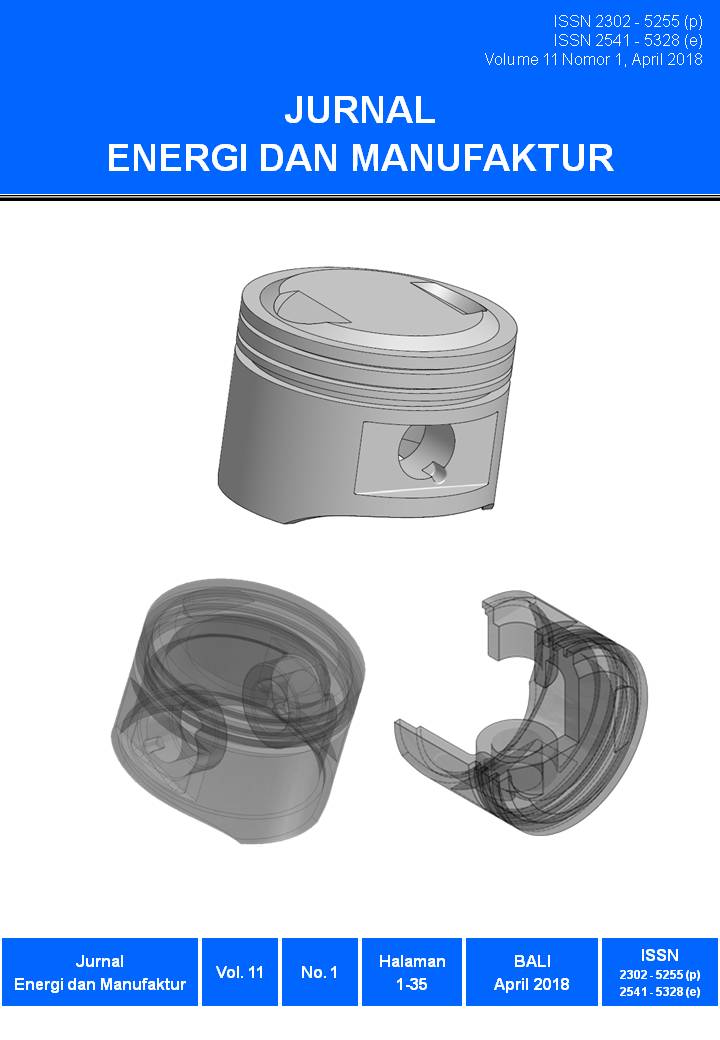Pengaruh Variasi Jarak Penghalang Segitiga di depan Silinder Arah Vertikal terhadap Drag
Abstract
Salah satu cara untuk menghemat energi pada pesawat terbang dan bluff body lainnya adalah dengan mengurangi drag. Drag erat hubungannya dengan separasi aliran. Semakin awal terjadi separasi maka drag semakin meningkat. Oleh karena itu upaya yang dilakukan untuk mengurangi drag adalah dengan memanipulasi medan aliran fluida. Manipulasi aliran bisa dilakukan secara pasif antara lain menempelkan sebuah sirip pada bluff body, melubangi bluff body, menambahkan spiral pada bluff body dan menempatkan penghalang yang lebih kecil didepan bluff body. Penelitian ini yaitu dengan cara menempatkan penghalang berbentuk segitiga didepan silinder. Dalam penelitian ini pengujian dilakukan pada wind tunnel, yang terdiri dari blower, pipa pitot, manometer, pipa silinder, dan segitiga penghalang. Penempatan penghalang divariasikan pada arah vertikal posisi y = 0, y = 5 mm, y = 10 mm, y = 15 mm, sedangkan posisi penghalang pada arah horisontal pada jarak 60 mm terhadap silinder dengan panjang sisi segitiga adalah 8 mm. Distribusi tekanan diperoleh dengan mengukur tekanan permukaan silinder pada 36 titik dengan interval 10o. Data yang diukur adalah tekanan permukaan silinder, tekanan statis, dan kecepatan aliran fluida. Hasil penelitian menunjukkan bahwa terjadi penurunan drag pada saat diberi penghalang segitiga dibandingkan dengan tanpa diberi penghalang segitiga. Nilai koefisien drag untuk silinder tanpa diberi penghalang yaitu 0.1276. Sedangkan dari variasi jarak penghalang pada arah vertikal diperoleh penurunan koefisien drag tertinggi adalah pada posisi y = 0 yaitu sebesar 0,0186. Besarnya penurunan drag pada posisi ini adalah 85,45% dibandingkan dengan tanpa penghalang.
One of the ways to reduce energy consumption an airplane and the other bluff body is by decreasing the drag. The drag is closely related to the flow of separation. The early separation, then the drag will increase. Based on the fact the effort to decrease drag is conducted by manipulating the field of fluid flow. The stream manipulation can be done passively, for example, by attaching a fin at the bluff body, by making a hole on the bluff body, enhancing spiral at the bluff body and placing a smaller barrier, on front of bluff body. The experiment was done by placing a triangle rod on front of the cylinder. In the present research the experiment was conducted in a wind tunnel, which consisted of a blower, a pitot pipe, a manometer, a main cylinder pipe, and a triangle rod. The triangle was variation vertical positioned at y = 0 mm, y = 5 mm, y = 10 mm, y = 15 mm. while the position of barrier in the horizontal direction at 60 mm distance towards the cylinder with the triangle side length was 8 mm. Pressure distribution was measured on 36 points at the cylinder surface with an interval of 100. The measured data was the pressure of cylinder surface, the static pressure, and the airflow speed.The research results showed that the triangle rod could decrease the drag of the main cylinder. The Coefficient drag for the cylinder without the triangle rod was 0, 1276 while the variation of barrier in the vertical direction obtained the biggest decrease of the coefficient of the drag with the triangle rod happened at position y = 0, which was 0, 0186. The magnitude of the drag reduction in this position was 85, 45% compared without barrier.
Downloads
References
[2] Chew, Y T., L S Pan, & T S Lee, NumericalSimulation Of The Effect Of a Moving Wall On Separation Of Flow Past a Symmetrical Aerofoil, ImechE, 212.1997.
[3] Fox, R. W.,Introduction To Fluid Mechanics, John Wiley & Sons, New York, 1985.
[4] Igarashi, T., Drag Reduction Of a Square Prism by Flow Control Using a Small Rod, Journal of Wind Engineering and Industrial Aerodynamics, 69 – 71, 141 – 153, 1997.
[5] Incropera, F. P. & D. P. DeWitt. 1981. Fundamentals Of Heat And Mass Transfer, John Wiley & Sons, New York, 1981.
[6] Lee, S., S. Lee, & C. Park, Reducing The Drag On a Circular Cylinder by Upstream Installation Of a Small Control Rod, Fluid Dynamics Reseach , 34: 233-250, 2004.
[7] Tsutsui, T. & T. Igarashi, Drag Reduction of a Circular Cylinder in an Air-Stream, Journal of Wind Engineering and Industrial Aerodynamics, 90(2002): 527-541.
[8] Yajima, Y & O. Sano, A Note On The Drag Reduction Of a Circular Cylinder Due To Double Rows Of Holes, Fluid Dynamics Research, 18(1996): 237 – 243. 1996.

This work is licensed under a Creative Commons Attribution-NonCommercial-ShareAlike 4.0 International License.









